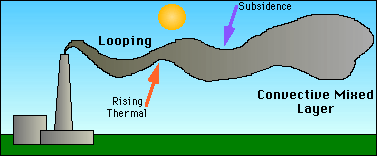
We discussed in Part 2 the structure of the PBL, including the mixed, stable, and residual layers. Let's say a factory is releasing chemical pollutants from a tall stack. During the day, the pollution is releases into the mixed layer. The convection within the mixed layer quickly disperses the pollutants downwind. We also notice the typical looping of the plume. This is caused by rising thermals in some areas and subsidence in others. Subsidence is higher pressure air which sinks. On a day with lots of puffy cumulus clouds, the clouds are areas of upward motion and the clear sky around the clouds are areas of subsidence. The combination of rising and sinking air quickly mix the pollutants from the stack and lead to the looping plume. The rapid mixing of particles in the mixed layer is beneficial in that it prevents the build-up of pollution into dangerous concentrations in any one area.

If a similar factory were to release pollution during the night from a tall stack, the plume would spread out evenly, a process called coning. This is due to the neutrally stable profile of the residual layer. If a plume were released from a short stack within the stable layer, the plume would not disperse very quickly and behave in the process called fanning (if you were looking down on the factory, it would look like a fan of smoke). Coning disperses particles more effectively than fanning. Fanning disperses pollution in the horizontal, but not very effectively in the vertical.

Pollution also influences rain and fog in the PBL. It is the pollutants that are trapped in the PBL that collect in clouds and then return to the earth's surface as acid rain. If the there is sufficient moisture in the stable layer, then fog will form. Fog with high pollution concentrations is a serious health risk to people and plants.
Because pollution is released into the PBL, processes with in the PBL naturally affect our air quality. A stable PBL can have dangerous effects in heavily polluted areas, whereas an unstable PBL can mean effective pollution dilution.
 The Shodor Education Foundation, Inc.
The Shodor Education Foundation, Inc.